Most recreational vehicles in America do not have an aesthetic that would be described as “pretty.” Aside from weird independent brands and Airstream, most of the time you get a boring box that’s roughly modeled after whatever the current trend in home design is. If you’re looking for something a bit different, I found a rare pick. This is a 1961 Holiday House, and it looks like nothing else. Unfortunately, it does come with a catch.
Something that I’ve always found fascinating is that campers are a lot like cars, in that some of the rarest survivors are sometimes found in places with great weather. If you live in the Rust Belt like I do, you’ll be blown away the first time you go to California. All of your childhood cars that have long rusted away at home are still alive in California.
The same is seemingly true for RVs. It’s no secret that most RVs throughout history were not built to last several decades, and if you’re an RV fan living in a place with rain and snow, you will likely deal with water leaks and rot at least once in your life. The Midwest is littered with old campers that have lost the battle against water and have deteriorated beyond practical restoration.
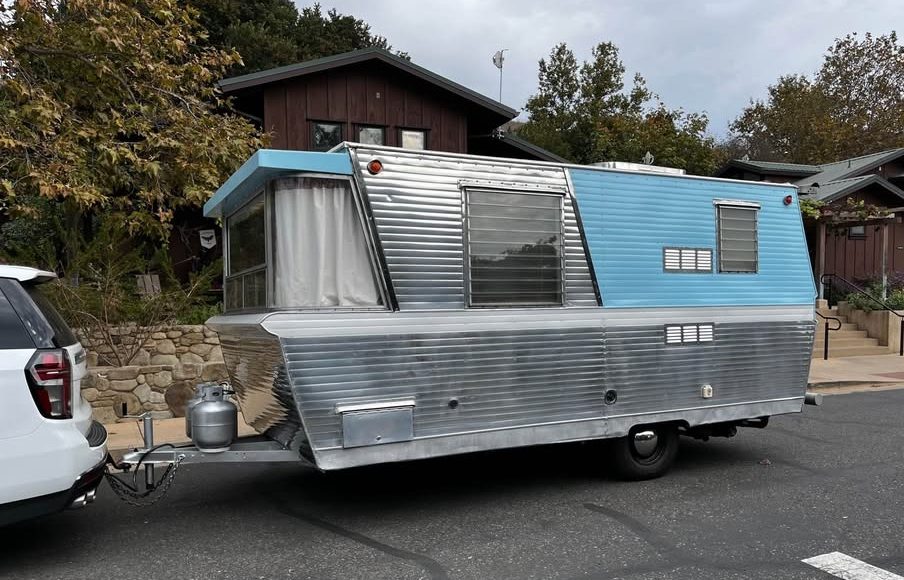
Holiday House campers are a rare breed. They were originally built for only a few years, and many of the ones that were built have long succumbed to the environment. Yet, to my own shock, I have found not just one, but two Holiday House survivors for sale in California. Here’s why these beauties are worth a look if you want something vintage.
A Wild Side Hustle
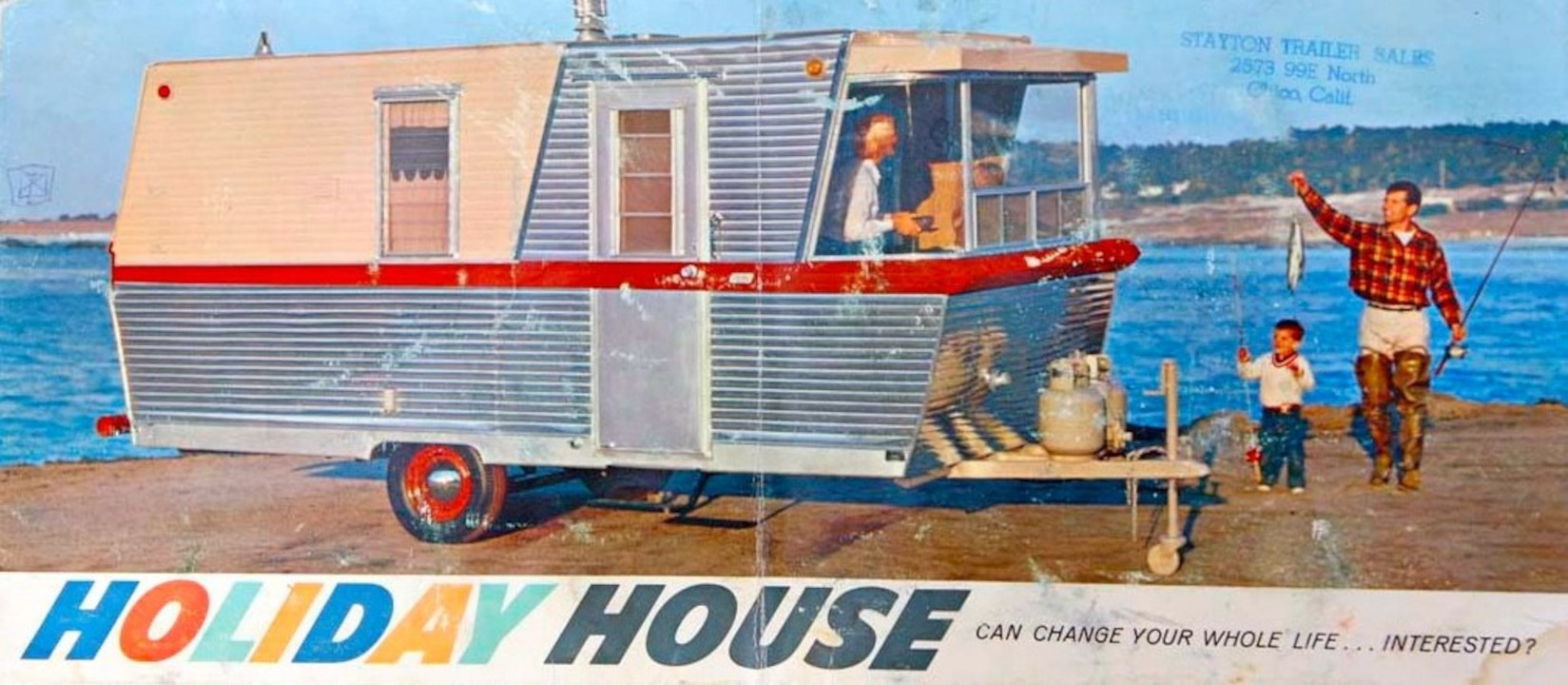
I have written about Holiday House before, sort of. Let’s start with some history from my previous coverage:
[T]he Holiday House name was created in 1959 by David Holmes. Back then, Holmes was president of Harry & David, a mail-order fruit gift basket company from Medford, Oregon. Holmes had a problem as demand for fruit baskets was low from January to July, leaving his skilled workers without much to make. Apparently, this was the perfect opportunity for Holmes to flex his love for modern design and his lifelong interest in campers. When Holiday House production kicked off on November 2, 1959, the trailers featured a typical build for the day. Holiday House trailers featured wooden framing with aluminum skin and a steel chassis. What made Holiday House stand out was its space-age design, which remains striking today, more than six decades later.
During the short lifespan of Holiday House, Holmes enlisted the help of industrial designer Charles “Chuck” Pelly. In those days, Pelly was known for designing the Scarab sports car for Lance Reventlow. Later, Pelly’s resume would include founding Designworks/USA and working on BMW designs including the X5, Z4, 3 Series, and Rolls-Royce. Other highlights of Pelly’s career include set design for the television show Lost in Space, the interiors of Disney’s California monorails, and the Chaparral 1 racer.
Pelly is also credited with designing the Holiday House Geographic, a fantastic limited-production fiberglass camper with a mid-century modern design, an original price tag of $8,500, and was marketed as a “Trailer For The Rich” with lavish appointments.

Holiday House sold trailers in 17-foot to 24-foot lengths, but none of them sold well. There were several factors working against the success of the company. One of the biggest detriments was that Holiday House was more or less just a side hustle for Harry & David. The campers were built only during the slow season for gift fruit baskets, and the business was never full-time.
Another problem working against Holiday House is that while the company created a striking Space Age design, under the glitz and glamour was a standard wood-framed “stick-built” camper. Holiday House didn’t really move the needle on trailer longevity, only style.
Production ended in January 1962, after only a few seasons of production. It’s believed that there were roughly 200 or so standard Holiday House builds. The Holiday House holy grail is the aforementioned Holiday House Geographic, which is believed to have sold only seven to 10 units, of which possibly only one survives today. The Holiday House factory burned down in June 1962, and the remains of the company were discarded.
Born Again, And Then Dead Again
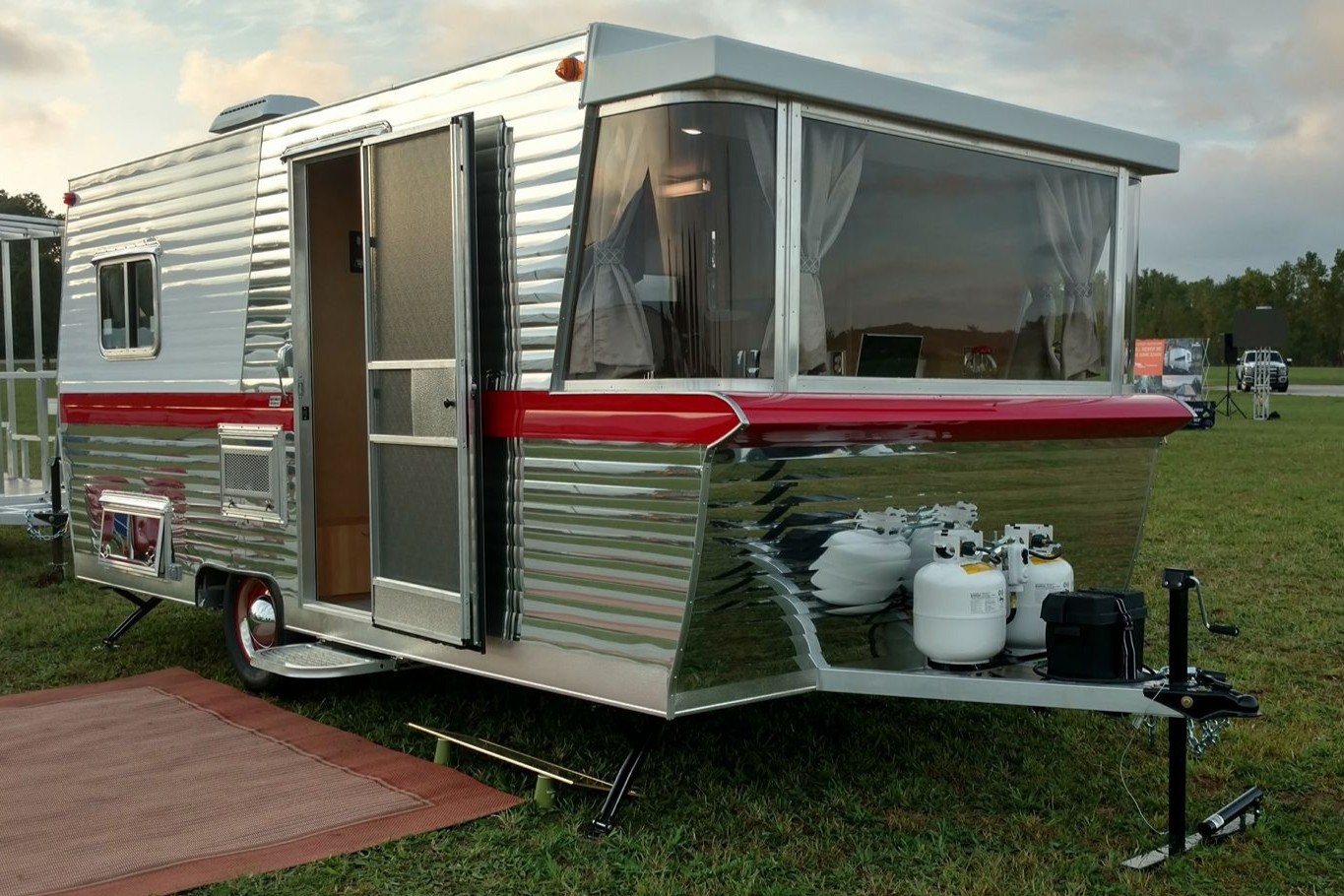
Despite the company’s outrageously short lifespan, its designs made an impact. In the decades following Holiday House’s failure, multiple entities purchased the Holiday House name, including Holiday Rambler, but none did anything with it. That finally changed in 2014 when inTech RV and RV executive Mark Lucas bought the name and put Holiday House back into production in 2017.
The new Holiday House considered its trailers a “continuation series,” but it’s important to note that this new company had no real connection to the old one, as all of Holiday House’s original molds were thrown away. So, the new trailers looked the part, but they weren’t exactly a true continuation.
In one way, that was a good thing. The “continuation” Holiday House trailers had aluminum framing and an aluminum chassis, vast improvements over the old ones.
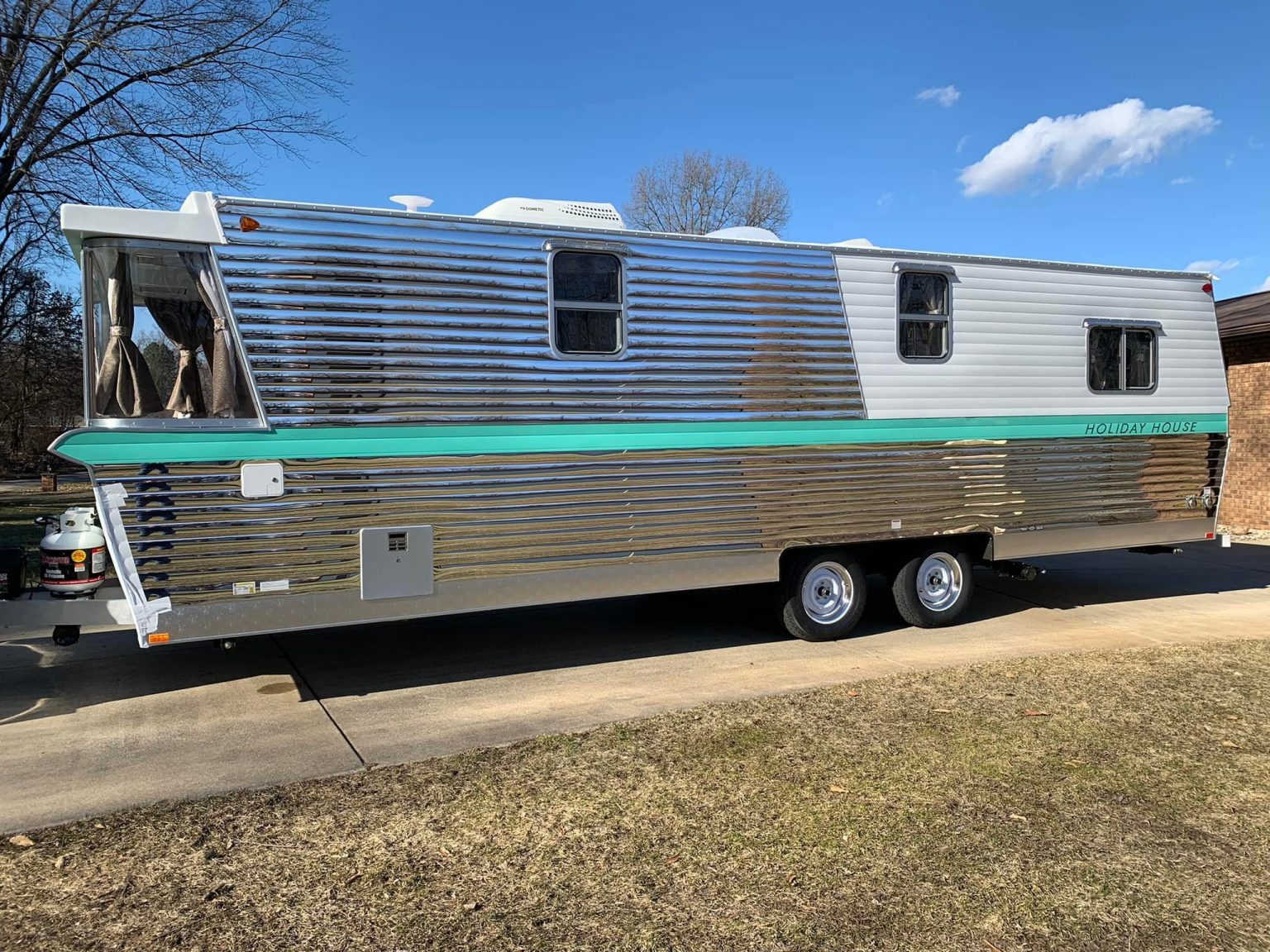
I wrote about these new campers a couple of years ago. Not long after, a reader and Holiday House owner named Austin reached out to me and informed me that the new Holiday Houses might have been giant piles of crap. In April 2023, the National Highway Traffic Safety Administration opened an investigation into Holiday House, claiming:
Holiday House trailers built with multiple flooring sections instead of the designed one-piece, solid floor, cannot properly support the structure, allowing it to collapse, possibly in-transit.
The Office of Defects Investigation (ODI) has received five (5) complaints from owners of Holiday House trailers who have had floors collapse and/or frames sag before breaking. One instance of collapse happened while the trailer was in transit.
ODI contacted the manufacturer, who was aware of these concerns, and has been working to repair or buy back these trailers since at least the summer of 2022, but has not been able to remedy them all. The manufacturer stated that the trailers were incorrectly built with 3-piece floors instead of a 1-piece floor. The manufacturer has also claimed that its sole production facility has been closed and staff laid off since mid-December 2022, however, on-line resources indicate trailers for sale and updates for 2023 models.

The investigation alleged that these new trailers had frames that were too small to support the new Holiday Houses, and thus, you got the complaints above. It’s unclear exactly when Holiday House ended production, but the company’s website is gone now, and the Holiday House name is dead yet again. Thankfully, our dear reader was able to find a professional fabricator who fixed their Holiday House into the trailer it should have been from the start.
Weirdly, because of these catastrophic issues, this will be one of the rare times when I recommend a stick-build over metal. I know, I can’t believe I’m saying that, but here we are.
These Holiday Houses
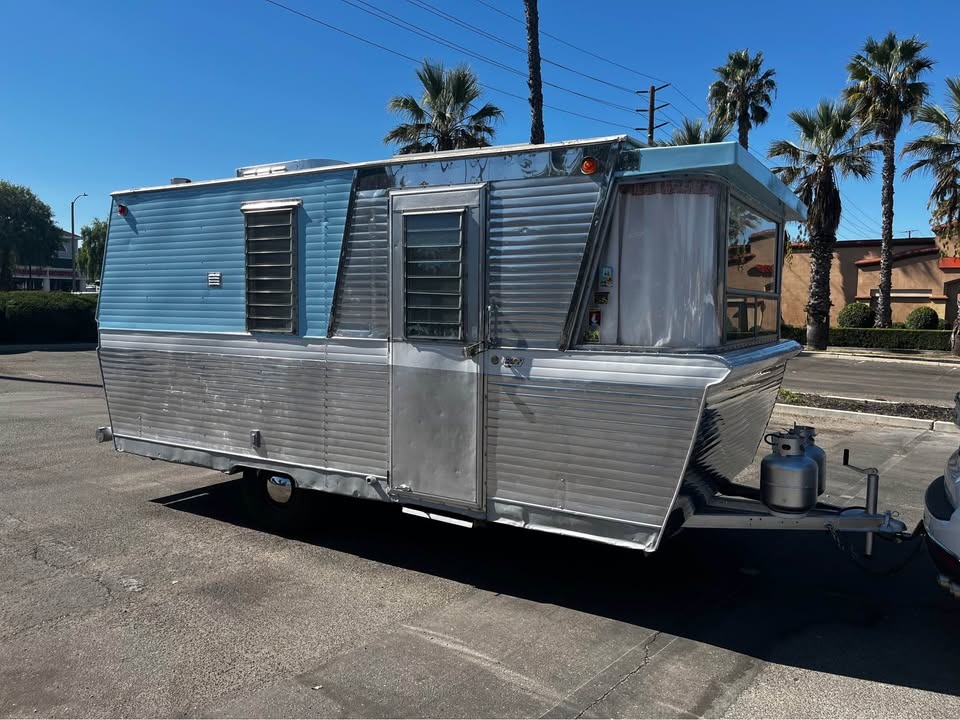
If you can live with the maintenance of a vintage stick-built camper, there are two beautiful vintage Holiday Houses for sale in California right now. The first is this 1961 Holiday House H20LR1. It comes in at a reasonable 20 feet long and has just enough modernization to be usable today.
The aluminum skin on this one presents in decent shape overall, with only a few dents to speak of. Something I like about this design is that there are a lot of cool touches going on. Some of the aluminum is polished, while some of it is painted. You end up with a sweet tri-tone look that’s rather striking.
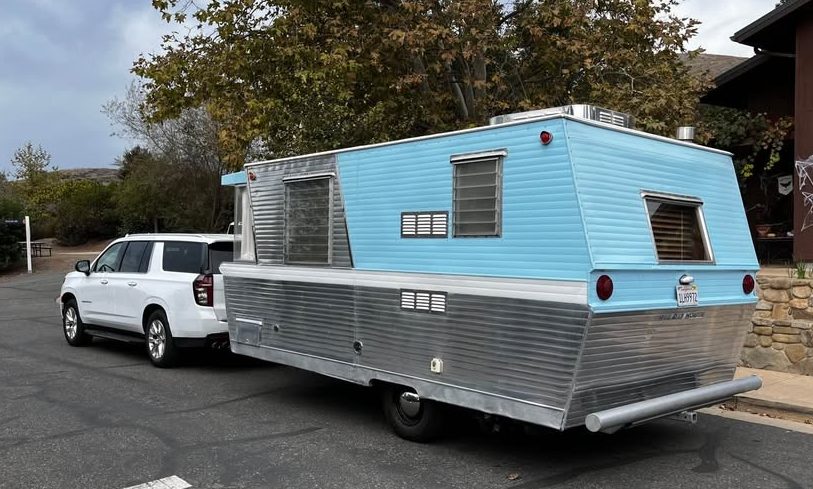
Here is what the seller says about the interior:
Rare Lounge model 20’. Very nice condition. New roof mounted low profile air conditioner/heater with custom polished aluminum cover. Working refrigerator, tankless water heater, new toilet, new water lines to shower. Sofa folds down to comfortable double bed. Nice awning included. New propane tanks. Original stove in great condition. Last towed to Modernism Trailer show in Palm Springs, tows great.
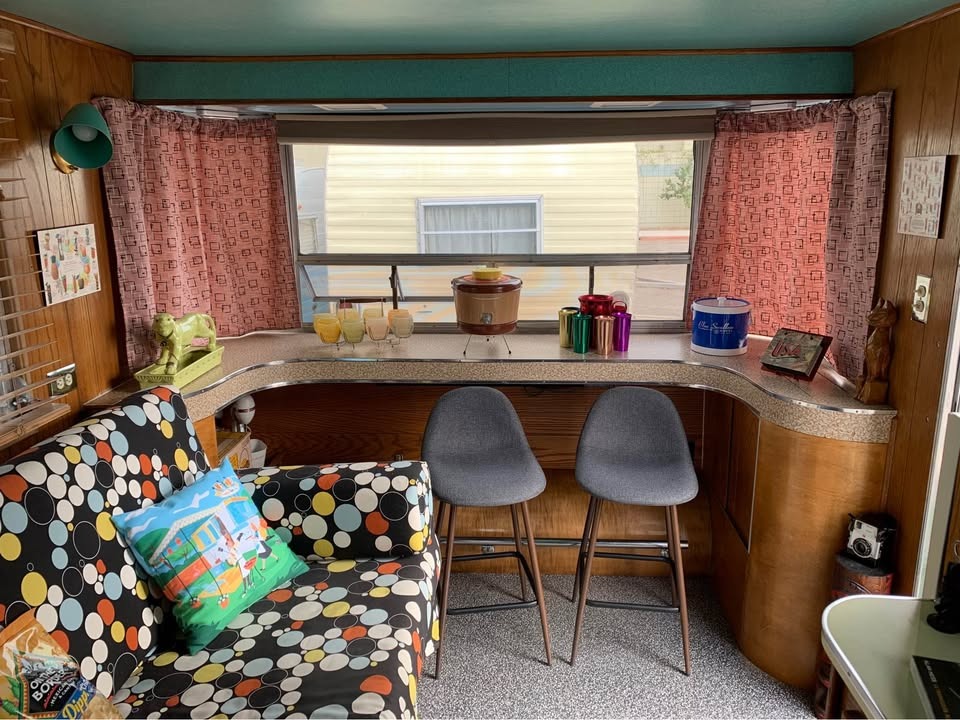
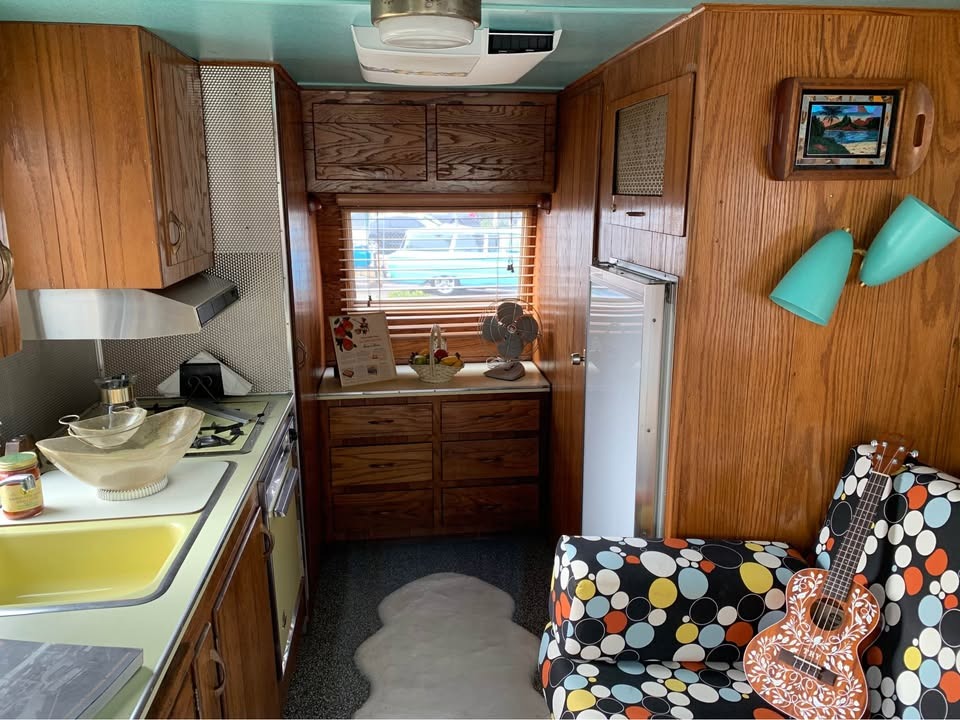
What sets this one apart is its front room. A typical Holiday House has a dinette up front with a table and two booths. This trailer has a neat sort of bar and lounge setup going on up front. I think this is a little less practical than a dinette, and it is a little weird having a couch directly across from the kitchen, but it sure looks neat.
That couch, which turns into a bed, is this trailer’s only sleeping area, so this trailer is strictly a couple’s camper only. If you look beyond the couch, there is the kitchen, a dry bathroom, and storage – that’s it. That said, I do find it pretty cool that such a small trailer has its toilet separated from the shower.

The other option here is another 1961 model. We aren’t given a size, but from my eyes, this is a Holiday House 18. This little guy has the same tri-tone thing going on outside, but the interior is where things get very different.
From the listing:
Highlights:
• 1961 Holiday House – very rare
• Excellent, well-maintained condition
• Distinctive modern styling, far ahead of its time
• Built with upgraded chassis & larger bathroom unique to the ’61 models
• Sleeps 3 comfortably
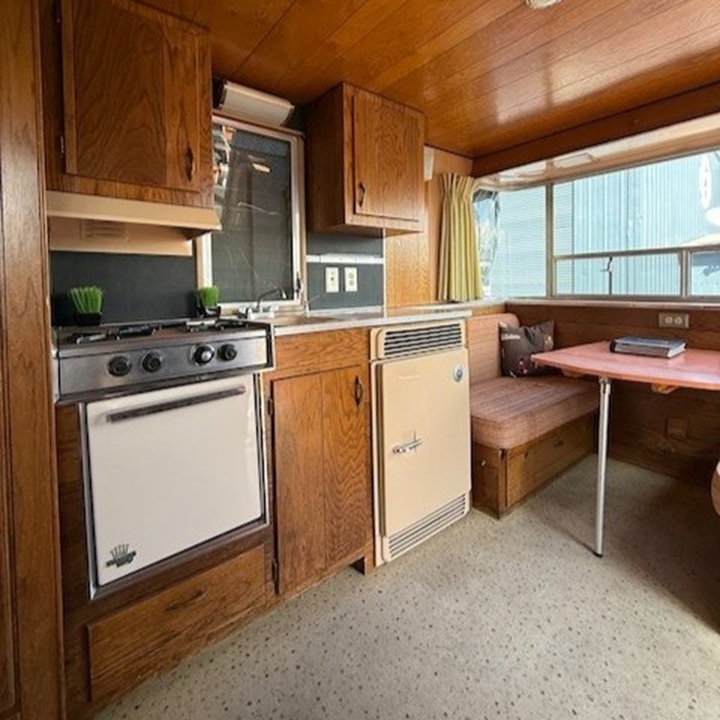

• Gas oven
• Heater
• Refrigerator
• Sink
• Dining room
• Cabinet storage
• Closet
• Shower
• Toilet
We’ve owned it since 2011 and have enjoyed it for both business and pleasure. It’s been a head-turner everywhere we’ve taken it — from surf and camping trips to showroom displays, company promotions, and as a trade show booth.
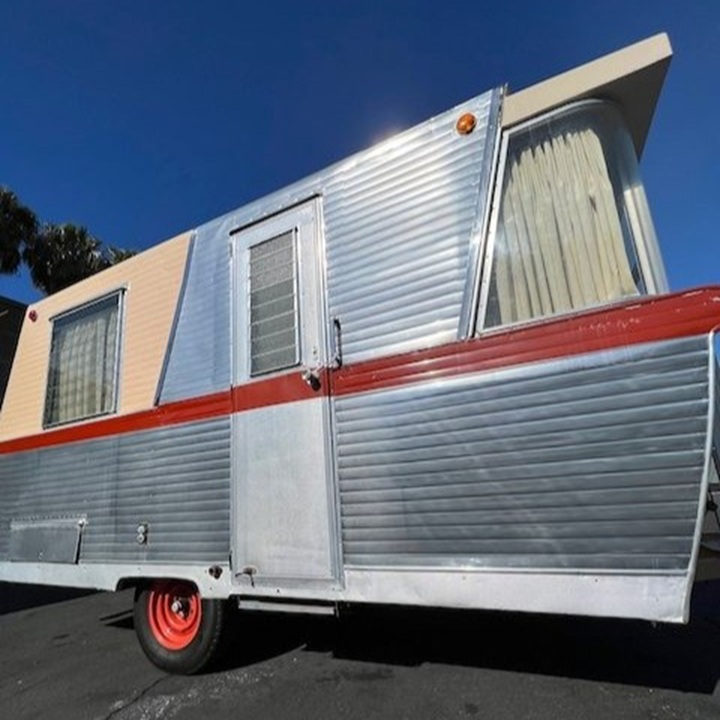
As you can see, this one has a more typical dinette. It also appears to be more original than the other trailer in this piece. However, that also means no air-conditioner. I love how old-school that refrigerator is. Another upside here is that this trailer has two sleeping areas. This one also has a bathroom, too!
Imperfectly Great
The blue one is for sale in Chatsworth, California, for $29,000, and the coral one can be found in Newport Beach, California, for $35,000. It’s unclear how much either of these weighs, but vintage campers do typically weigh less than modern trailers of the same length. So, I would expect both of these to come in at under 4,000 pounds.

Of course, rigs like these are going to need proper tow vehicles. Maybe a 1960s two-tone pickup truck? What would be the best vehicle to tow these?
The Holiday House story is a sad one. The company had a distinctive design, but never committed enough to sell many of them. Then it was revived into something that was supposed to be better, but couldn’t even hold itself together. So both of these campers are fascinating and rare time capsules. They came from a time when a camper’s form was nearly as important as its function, and they reflect the optimism America had for camping in the 1960s.
I do hope that this is not the end of the road for Holiday House, because this design is too wild to be lost in the pages of history. Though if someone takes a crack at the brand again, I also hope that they get it right the first time.

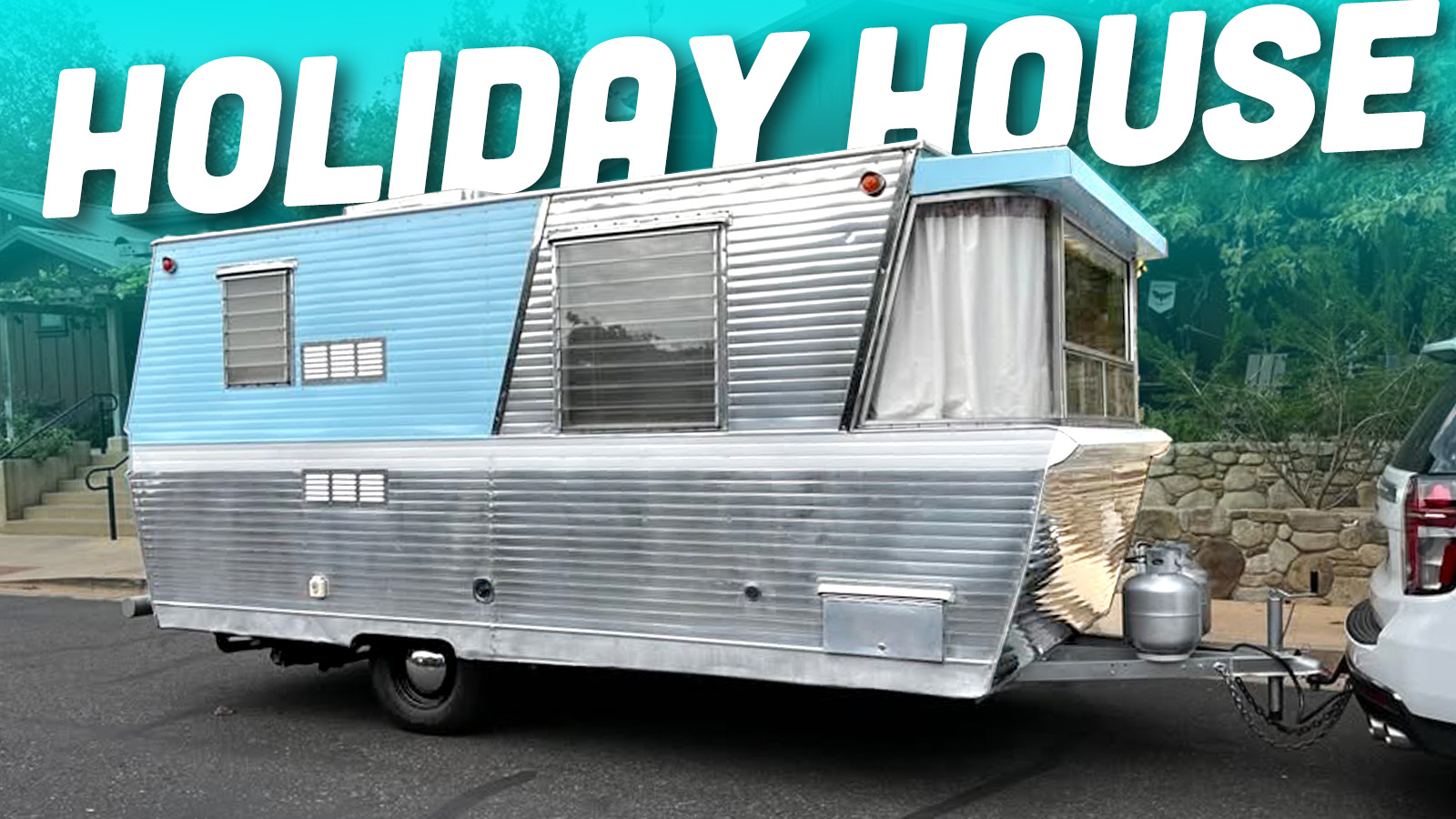



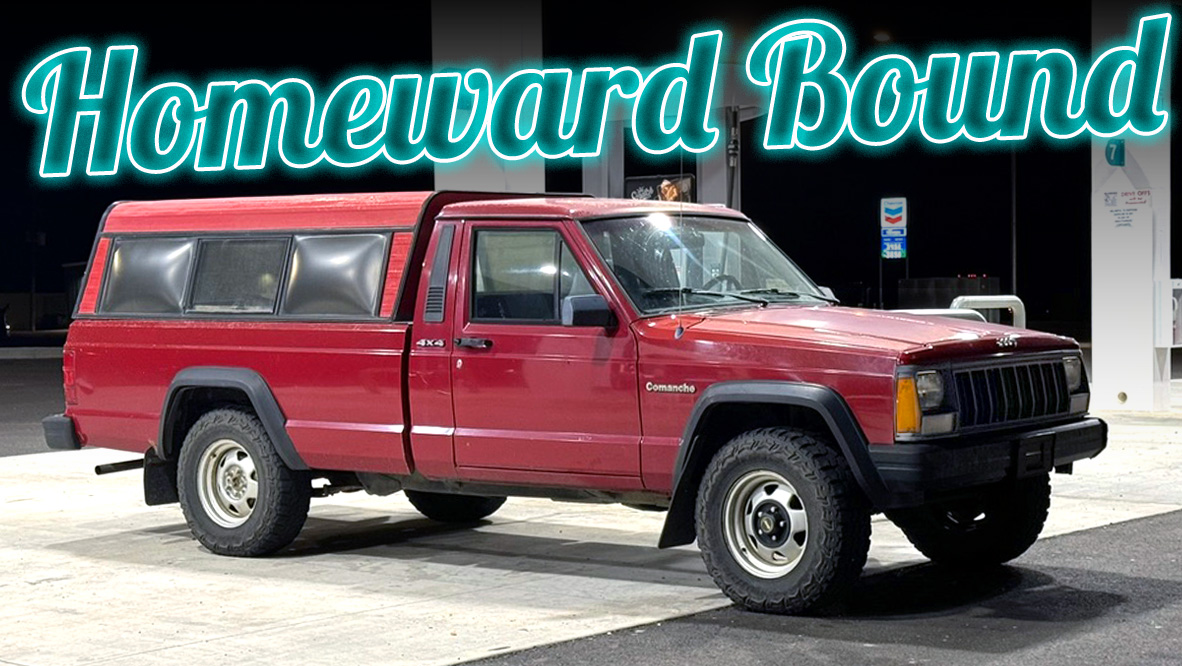
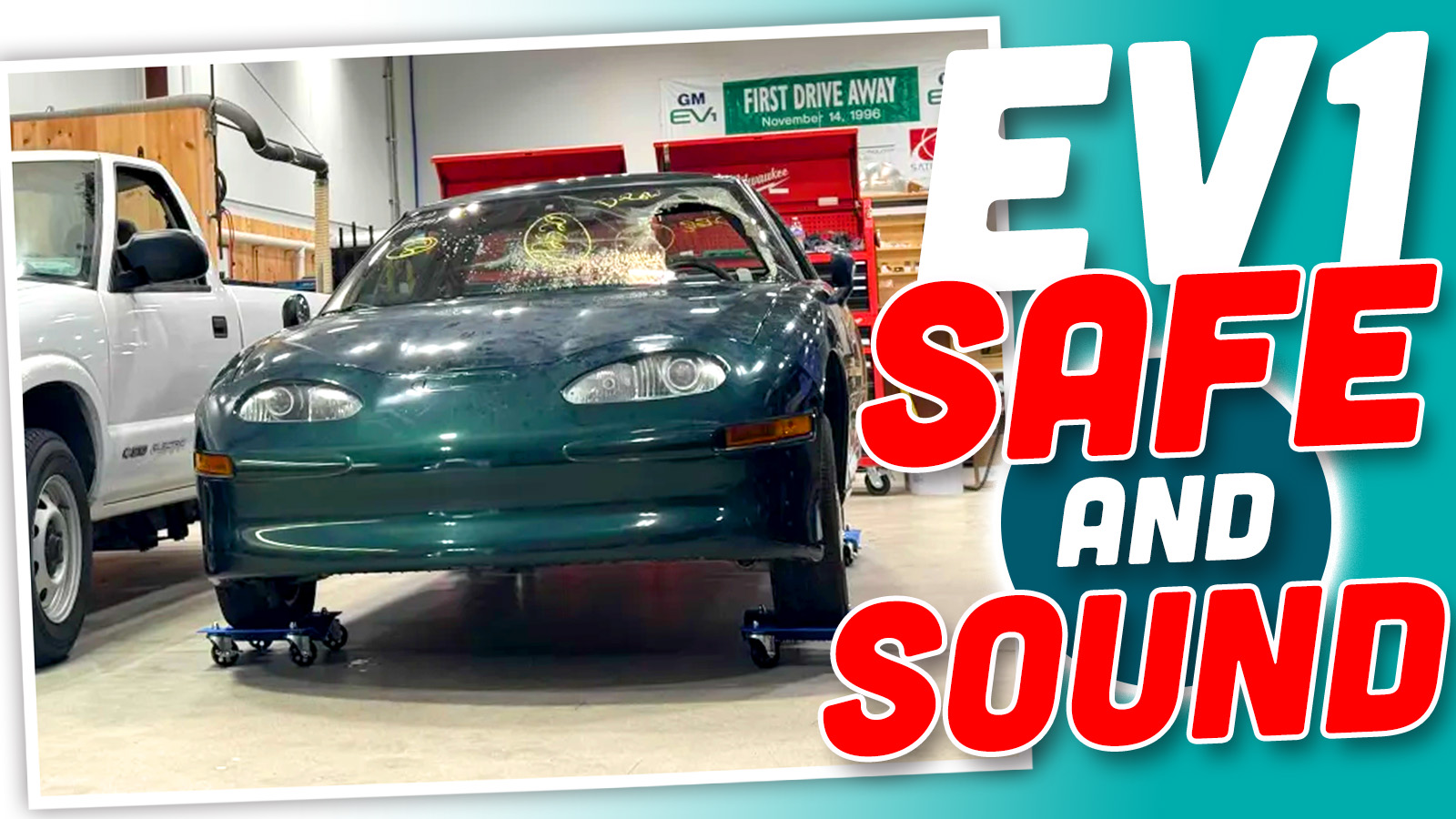

There’s a lovely updated vintage resort in Palm Springs called “Holiday House”
It looks nothing like the trailer inside or out.
It’s still highly recommended.
A fruit basket company deciding to build campers on the side is pretty wild.
Holy crap, those are some cool campers!
There’s always a catch.
Interesting. I passed one of these driving through northern California a few weeks ago and had no idea it was special, at least beyond the unique design.
Because of geography,
https://www.ebay.co.uk/itm/387671688863?hash=item5a4308869f%3Ag%3AFYgAAeSw79Jo8kOl&mkevt=1&mkcid=1&mkrid=710-53481-19255-0&campid=5337447213&customid=&toolid=10049
These are really cool.
I’ll never own another camper without AC though. Not that I could afford these anyways.
Oh wow. I like the base model, but that Geographic X model is superb! I searched and there are only 2 seemingly fully restored out there. At least they are out there though.